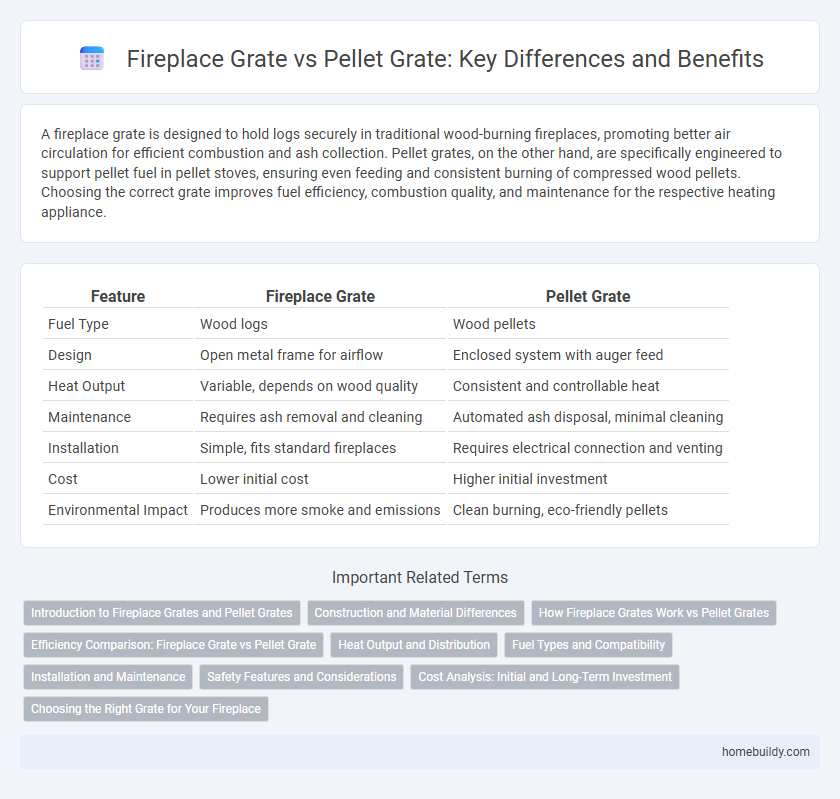A fireplace grate is designed to hold logs securely in traditional wood-burning fireplaces, promoting better air circulation for efficient combustion and ash collection. Pellet grates, on the other hand, are specifically engineered to support pellet fuel in pellet stoves, ensuring even feeding and consistent burning of compressed wood pellets. Choosing the correct grate improves fuel efficiency, combustion quality, and maintenance for the respective heating appliance.
Table of Comparison
| Feature | Fireplace Grate | Pellet Grate |
|---|---|---|
| Fuel Type | Wood logs | Wood pellets |
| Design | Open metal frame for airflow | Enclosed system with auger feed |
| Heat Output | Variable, depends on wood quality | Consistent and controllable heat |
| Maintenance | Requires ash removal and cleaning | Automated ash disposal, minimal cleaning |
| Installation | Simple, fits standard fireplaces | Requires electrical connection and venting |
| Cost | Lower initial cost | Higher initial investment |
| Environmental Impact | Produces more smoke and emissions | Clean burning, eco-friendly pellets |
Introduction to Fireplace Grates and Pellet Grates
Fireplace grates are designed to hold firewood securely, allowing optimal airflow for efficient burning and heat distribution in traditional wood-burning fireplaces. Pellet grates, on the other hand, are specifically engineered to support wood pellets, promoting even combustion and minimizing ash buildup in pellet stoves. Understanding the differences in material composition and airflow design helps in selecting the right grate to enhance fuel efficiency and fireplace performance.
Construction and Material Differences
Fireplace grates are typically constructed from cast iron or steel, designed to withstand high temperatures and support traditional wood logs, while pellet grates are made from specialized stainless steel or ceramic materials to accommodate consistent pellet fuel combustion. The construction of fireplace grates emphasizes open bars for air circulation and ash fall-through, whereas pellet grates feature a more compact, perforated surface optimized for pellet feed and ash management. Material durability and heat resistance vary, with pellet grates often incorporating corrosion-resistant alloys to handle the distinct burn characteristics and residues of pellets.
How Fireplace Grates Work vs Pellet Grates
Fireplace grates support and elevate wood logs, allowing air to circulate beneath for improved combustion and ash management in traditional wood-burning fireplaces. Pellet grates, designed specifically for pellet stoves, have a metal grid structure that allows pellets to feed into the burn pot continuously while promoting controlled airflow for efficient pellet combustion. The key difference lies in their compatibility and airflow design, with fireplace grates optimized for manual log placement and pellet grates engineered for automated pellet feeding and consistent heat output.
Efficiency Comparison: Fireplace Grate vs Pellet Grate
A fireplace grate is designed to hold wood logs, promoting airflow and enhancing combustion efficiency, which results in consistent heat output and optimal fuel usage. Pellet grates, integrated into pellet stoves, use automated feeding systems to maintain precise fuel delivery, maximizing energy efficiency and reducing emissions significantly compared to traditional wood grates. While fireplace grates offer a natural burning experience with moderate efficiency, pellet grates excel in fuel economy and heat control, making them a superior choice for energy-conscious users.
Heat Output and Distribution
A fireplace grate typically allows for higher heat output by providing better airflow to traditional wood logs, resulting in more efficient combustion and radiant heat distribution throughout the room. In contrast, a pellet grate is designed specifically for pellet stoves, offering consistent and controlled heat output with less radiant heat but more even heat distribution due to the forced air system. Choosing between the two depends on whether maximum heat output or steady, uniform heat distribution is the priority.
Fuel Types and Compatibility
Fireplace grates are designed primarily for wood-burning fires, accommodating logs and ensuring proper airflow for efficient combustion. Pellet grates, on the other hand, are specifically engineered to work with compressed wood pellets, requiring compatibility with pellet stove systems for optimal fuel feeding and burning. Choosing the correct grate depends on the fuel type, as traditional fireplace grates are unsuitable for pellets, while pellet grates cannot handle larger wood logs effectively.
Installation and Maintenance
Fireplace grates typically require straightforward installation by placing them inside the firebox, while pellet grates often need specialized fitting to accommodate pellet stoves. Maintenance for traditional fireplace grates involves regular ash removal and occasional cleaning to prevent rust, whereas pellet grates demand more frequent inspections and cleaning to manage pellet ash buildup and ensure efficient pellet combustion. Choosing the right grate depends on balancing ease of installation with the specific cleaning needs dictated by fuel type.
Safety Features and Considerations
Fireplace grates are designed primarily for traditional wood-burning fires, focusing on maintaining airflow and containing logs safely, while pellet grates incorporate safety features like enclosed combustion chambers and automated feed systems to prevent sparks and regulate heat output. Pellet grates often include sensors to monitor temperature and fuel levels, reducing the risk of overheating or fire hazards compared to standard fireplace grates. Proper installation and regular maintenance are critical for both types to ensure optimal safety and efficient operation.
Cost Analysis: Initial and Long-Term Investment
Fireplace grates typically involve a lower initial purchase price compared to pellet grates, which often require more advanced materials and manufacturing. Long-term investment for fireplace grates includes maintenance and replacement costs, generally lower than pellet grates that demand specific components for pellet combustion. Evaluating total cost of ownership reveals pellet grates may incur higher expenses due to fuel costs and mechanical upkeep, despite potential efficiency gains.
Choosing the Right Grate for Your Fireplace
Choosing the right fireplace grate enhances combustion efficiency and heat output by matching the fuel type and fireplace design. Traditional fireplace grates are ideal for burning logs, providing optimal air circulation and durability, while pellet grates are specifically designed to support pellet stoves, ensuring even fuel feeding and minimizing ash buildup. Selecting the appropriate grate improves safety, fuel consumption, and maintenance, making it essential to consider the specific requirements of your fireplace setup.
fireplace grate vs pellet grate Infographic

 homebuildy.com
homebuildy.com